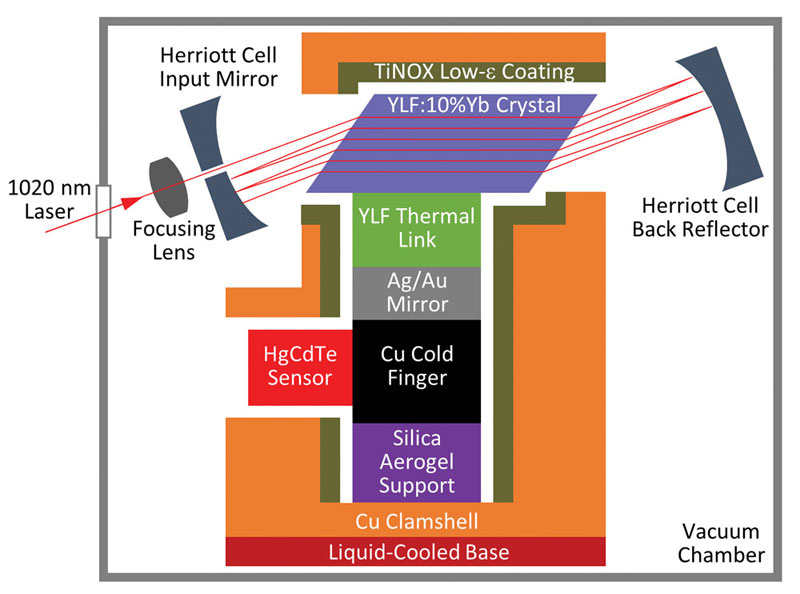ALBUQUERQUE and LOS ALAMOS, N.M., June 22, 2018 — Researchers have demonstrated an all-solid-state optical cryocooler. The structure, which according to researchers is the first demonstration of laser cooling of a payload connected to a cooling crystal, could serve as a baseline for future optical crycooler devices.
Solid-state laser cooling is achieved using anti-Stokes fluorescence — a process in which the average wavelength of the fluorescence emitted by a material is shorter than the wavelength of the laser used for excitation. Anti-Stokes fluorescence cools macroscopic objects to cryogenic temperatures without vibrations.
The all-solid-state optical cryocooler has several key components. First, a high-quality YLF:Yb crystal was used to provide efficient cooling at the heart of the cryocooler. Second, a thermomechanically reliable van der Waals bond was created between Yb3+-doped and undoped YLF (yttrium lithium fluoride), and this allowed the incorporation of a transparent thermal link without the use of optical adhesives. This thermal link was then attached to a cold finger, which allowed cooling of an arbitrary payload. Third, use of hydrophobic silica aerogels provided excellent thermal insulation and sufficient mechanical strength to support the laser-cooled assembly.

The laser-cooling material (blue) is placed inside an astigmatic Herriott cell to enable multipass excitation by the pump laser. The sensor payload (red) is connected by a cold finger (black), mirror (gray), and thermal link (green) to the laser-cooling material. A support element (purple) provides the mounting of this assembly within a closely fitting clamshell (orange), which is lined with a low-emissivity coating (olive) and mounted onto a liquid-cooled base (dark red). The cryocooler is contained within a vacuum chamber (gray box). Courtesy of University of New Mexico and Los Alamos National Laboratory.
For the experiment, a research team from the University of New Mexico and Los Alamos National Laboratory placed a YLF:Yb crystal inside a Herriott cell and pumped it with a 1020-nm laser to cool a mercury cadmium telluride (HgCdTe) sensor, which was part of a working Fourier transform infrared (FTIR) spectrometer, to 135 K.
Fluorescence heating of the payload was minimized by using a single-kink YLF thermal link between the YLF:Yb cooling crystal and the copper coldfinger that held the HgCdTe sensor. The adhesive-free bond between YLF and YLF:Yb showed excellent thermal reliability.
This laser-cooled assembly was supported by silica aerogel cylinders inside a vacuum clamshell to minimize undesired conductive and radiative heat loads from the warm surroundings.
According to researchers, the cryocooler is the only solid-state cooling device that works in the cryogenic regime, that is, in the temperature range of liquid cryogens with a boiling point of 166 K.
Thermoelectric coolers, the most common solid-state refrigerators, cannot achieve temperatures nearly as low as 135 K.
The research team believes that the use of solid-state optical refrigeration to cool a payload to cryogenic temperatures represents a breakthrough, and that the technology could be used to provide reliable cryogenic refrigeration, without moving parts and associated vibrations, for a variety of applications.
The research was published in Light: Science & Applications (doi:10.1038/s41377-018-0028-7).